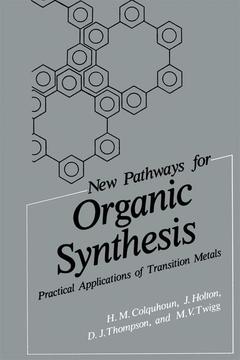1. Introduction.- 2. Formation of Carbon—Carbon Bonds.- 2.1. Formation of Carbon—Carbon Single Bonds.- 2.1.1. Preparation of Substituted Alkenes.- 2.1.2. Dienes and Polyenes.- 2.1.3. Substituted Alkynes.- 2.1.4. Substituted Arenes.- 2.1.5. Substituted Alkanes (By Conjugate Addition of Organocopper Reagents to Activated Alkenes).- 2.2. Formation of Carbon—Carbon Double Bonds.- 2.2.1. Catalytic Alkene Metathesis.- 2.2.2. Dehalogenation of vic-Dihalides and Coupling of gem-Dihalides, Aldehydes, and Ketones.- 2.2.3. Deoxygenation of Epoxides.- 3. Formation of Carbocyclic Compounds.- 3.1. Introduction.- 3.2. Formation of Three-Membered Rings.- 3.2.1. Carbene Addition to Alkenes or Alkynes.- 3.2.2. Cyclization Reactions.- 3.3. Formation of Four-Membered Rings.- 3.3.1. 2?-2? Cycloaddition of Alkenes.- 3.3.2. Cyclization Reactions.- 3.4. Formation of Five-Membered Rings.- 3.4.1. Cycloaddition Reactions Involving Alkenes, Alkynes, and Dienes.- 3.4.2. Cycloaddition of Two Unsaturated Species with a Third Substrate.- 3.4.3. Cyclization of Difunctional Substrates.- 3.5. Formation of Six-Membered Rings.- 3.5.1. Alkyne Trimerization—Formation of Aromatic Rings.- 3.5.2. Formation of Nonaromatic Six-Membered Rings from Alkynes.- 3.5.3. Cyclotrimerization of Alkenes and Allenes.- 3.5.4. Cyclodimerization of Dienes and Trienes.- 3.5.5. Cycloaddition of Dienes to Alkenes or Alkynes.- 3.5.6. Cyclization of Difunctional Substrates.- 3.6. Formation of Seven-Membered Rings.- 3.6.1. 3?–4? Cycloaddition Reactions.- 3.6.2. Cyclization of Difunctional Substrates.- 3.7. Formation of Eight-Membered Rings.- 3.7.1. Cyclodimerization of 1,3 Dienes.- 3.7.2. Cyclotetramerization of Alkynes.- 3.8. Formation of Large Rings (?9).- 3.8.1. Cycloaddition Reactions.- 3.8.2. Intramolecular Coupling.- 4. Formation of Heterocyclic Compounds.- 4.1. Introduction.- 4.2. Nitrogen Heterocycles.- 4.2.1. Three-Membered Rings.- 4.2.2. Four-Membered Rings.- 4.2.3. Five-Membered Rings.- 4.2.4. Six-Membered Rings.- 4.2.5. Seven-Membered Rings.- 4.3. Oxygen Heterocycles.- 4.3.1. Five-Membered Rings.- 4.3.2. Six-Membered Rings.- 4.4. Sulfur Heterocycles.- 4.5. Cyclic Compounds Containing Two Hetero Atoms.- 5. Isomerization of Alkenes.- 5.1. Introduction.- 5.2. Thermodynamic Considerations.- 5.3. Isolation of Organometallic Intermediates.- 5.4. Mechanisms of Catalytic Alkene Isomerization.- 5.5. Formation of a,?-Unsaturated Compounds.- 5.5.1. Propenyl Ethers from Allyl Ethers.- 5.5.2. ?,?-Unsaturated Aldehydes and Ketones from Diallyl Ethers.- 5.5.3. Ketones from Allylic Alcohols.- 5.5.4. Enamines from Allylamines.- 5.5.5. Propenylamides from N-Allylamines.- 5.5.6. a,?-Unsaturated Cyclic Ketones via Remote Double-Bond Migration.- 5.5.7. Intercoriversion of a,?-Unsaturated Ketones.- 5.6. Formation of Conjugated Dienes.- 5.7. Migration into Conjugation with Aromatic Rings.- 5.8. Formation of Aromatic Compounds—Isoaromatization.- 5.8.1. Formation of Substituted Phenols.- 5.8.2. Formation of Hydroxytropolones.- 5.8.3. Formation of Substituted Anilines.- 6. Direct Introduction and Removal of Carbonyl Groups.- 6.1. Preliminaries.- 6.2. Preparation of Carboxylic Acids, Esters, and Related Derivatives.- 6.2.1. Carboxylic Acids.- 6.2.2. Esters.- 6.2.3. Preparation of Amides.- 6.2.4. Preparation of Anhydrides.- 6.2.5. Preparation of Acyl Halides.- 6.3. Preparation of Aldehydes.- 6.3.1. Aldehydes: From Halides.- 6.3.2. Aldehydes: From Alkenes.- 6.3.3. Aldehydes: From Aldehydes and Silanes.- 6.4. Preparation of Ketones.- 6.4.1. Ketones: From Halides.- 6.4.2. Ketones: From Alkenes and Alkynes.- 6.4.3. Ketones: From Organomercury Compounds.- 6.5. Preparation of Isocyanates.- 6.6. Decarbonylation of Aldehydes and Acyl Halides.- 7. Reduction.- 7.1. Introduction.- 7.1.1. Hydrogenation.- 7.1.2. Transfer Hydrogenation.- 7.1.3. Transition Metal—Metal Hydride Reductions.- 7.2. Reduction of Triple Bonds.- 7.2.1. Formation of Alkanes.- 7.2.2. Formation of Alkenes.- 7.2.3. Selective Reductions.- 7.2.4. Formation of Polyunsaturated Species by Partial Reduction.- 7.3. Reduction of Double Bonds (Nonaromatic).- 7.3.1. Formation of Alkanes.- 7.3.2. Partial Reduction of Polyunsaturated Substrates.- 7.3.3. Reduction of Unsaturated Aldehydes and Ketones.- 7.4. Reduction of Aromatic Systems.- 7.4.1. Formation of Cycloalkanes.- 7.4.2. Partial Reduction of Aromatic and Polyaromatic Compounds.- 7.5. Reduction of Carbonyl Groups.- 7.5.1. Formation of Alcohols from Aldehydes and Ketones.- 7.5.2. Selective Reduction of Aldehydes and Ketones.- 7.5.3. Reduction of Carboxylic Acids and Acid Derivatives.- 7.6. Reduction of Nitro, Nitrile, and Other Nitrogen-Containing Functional Groups.- 7.6.1. Reduction of Nitro Groups.- 7.6.2. Partial Reduction of the Nitro Group.- 7.6.3. Selective Reduction of Nitro Compounds.- 7.6.4. Reduction of the Nitrile Functional Group.- 7.6.5. Formation of Mixed Amines from Nitriles.- 7.6.6. Selective Reduction of the Nitrile Group.- 7.6.7. Reduction of Oximes, Imines, and Nitroso Groups.- 7.7. Asymmetric Hydrogenation.- 7.7.1. Heterogeneous Catalysts.- 7.7.2. Homogeneous Catalysts.- 7.7.3. Mechanism of Asymmetric Hydrogenation.- 7.7.4. Asymmetric Hydrogenation of a-Acylaminoacrylic Acids.- 7.7.5. Optically Active Alcohols from Asymmetric Hydrogenation of Ketones.- 7.7.6. Asymmetric Hydrosilylation.- 7.8. Hydrogenolysis.- 7.8.1. Dehalogenation.- 7.8.2. Selective Reduction of Polyhalo Compounds.- 7.8.3. Hydrogenolysis of Benzylic and Allylic Groups.- 8. Oxidation.- 8.1. Formation of Alcohols.- 8.2. Formation of 1,2 Diols and Amino Alcohols.- 8.3. Acetoxylation.- 8.4. Epoxidation.- 8.4.1. Epoxidation of Allylic Alcohols.- 8.4.2. Asymmetric Epoxidation.- 8.5. Formation of Aldehydes and Ketones.- 8.5.1. Oxidation of Hydrocarbons.- 8.5.2. Oxidation of Alkenes and Alkynes.- 8.5.3. Oxidation of Alcohols.- 8.5.4. Oxidation of Amines.- 8.6. Formation of Acids.- 8.6.1. Oxidation of Alkanes and Alkenes.- 8.6.2. Oxidation of Alcohols.- 8.6.3. Oxidation of Aldehydes and Ketones.- 8.7. Formation of Esters.- 8.8. Dehydrogenation.- 9. Preparing and Handling Transition Metal Catalysts.- 9.1. Introduction.- 9.2. Preparation of Catalysts.- 9.2.1. Chlorotris(triphenylphosphine)rhodium(I)—RhCl(PPh3)3 (Wilkinson’s catalyst).- 9.2.2. trans-Chlorocarbonylbis(triphenylphosphine)-rhodium(I)—trans-RhCl(CO)(PPh3)2.- 9.2.3. Hydridocarbonyltris(triphenylphosphine)—rhodium(I)—RhH(CO)(PPh3)3.- 9.2.4. Dichlorotetrakis(ethylene)dirhodium(I)—[RhCl(C2H4)2]2.- 9.2.5. Dichlorotetracarbonyldirhodium(I)—[RhCl(CO)2]2 (Rhodium Carbonylchloride Dimer).- 9.2.6. cis-Dichlorobis(benzonitrile)palladium(II)—PdCl2(PhCN)2.- 9.2.7. Dichlorobis(triphenylphosphine)palladium(II)—PdCl2(PPh3)2.- 9.2.8. Tetrakis(triphenylphosphine)palladium(0)—Pd(PPh3)4.- 9.2.9. Palladium(II) Acetate Trimer—[Pd(CH3C02)2]3.- 9.2.10. Palladium on Charcoal.- 9.2.11. Lead-Conditioned Palladium on Calcium Carbonate—Selective Hydrogenation Catalyst (Lindlar Catalyst).- 9.2.12. Tetrakis- and Tris(triphenylphosphine)-platinum(0)—Pt(PPh3)4 and Pt(PPh3)3.- 9.2.13. Platinum Oxide Catalyst (Adams’Catalyst).- 9.2.14. Dicyclopentadienylcobalt(II)—Co(C5H5)2 (Cobaltocene).- 9.2.15. Nickel Dichlorobis(phosphine) Complexes—NiCl2(PPh3)2, NiCl2(Ph2PCH2CH2PPh2), and NiCl2(DIOP).- 9.2.16. Bis(l,5-cyclooctadiene)nickel(0)—Ni(C8H12)2.- 9.2.17. trans-Chlorocarbonylbis(triphenylphosphine)-iridium(I)—trans-IrCl(CO)(PPh3)2.- 9.2.18. Dichlorotris(triphenylphosphine)ruthenium(II)—RuCl2(PPh3)3.- 9.3. Metal Acetylacetonates.- 9.4. Arene Metal Tricarbonyls—ArM(CO)3 (M = Cr, Mo, or W).- 9.5. Transition Metal Carbonyls.- 9.6. Recovery of Precious Metals.- 9.7. Handling Air-Sensitive Compounds.- 9.7.1. Reactions under Nitrogen.- 9.7.2. Handling Solids.- 9.7.3. Schlenk-Type Glassware.- References.- Compound Index.




